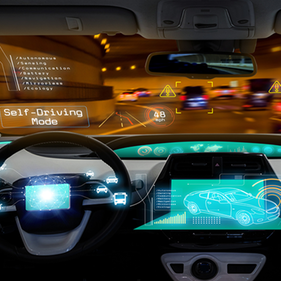Blockchain Can Increase Trust – And Value
Transparency is key to new business opportunities
A car is, after a home, the biggest purchase many people make – and maintaining it adds significant additional cost throughout the vehicle’s lifetime.
Given the high financial impact, trust-based relationships are important. However, car ownership is fraught with uncertainties. Widespread odometer tampering undermines trust in the second-hand market. Car servicing is often an opaque process, with the diagnosis of problems being made by the very people who will offer costly fixes. The growth of digital services has led to an increasing number of transactions and exchanges of personal data, which are hard to keep track of.
Blockchain technology could reduce many of these anxieties. It can record changes to an asset – such as ownership or alterations in status – in multiple locations, so that they cannot be altered without permission but can be consulted by authorized parties. That means it provides an immutable record that all parties trust.
For a car, the record can include ownership, as well as driving, accident, and maintenance history. To prevent odometer tampering, mileage and GPS data could be continuously registered in a vehicle’s digital logbook. A potential buyer could then easily verify the state of the vehicle: its service history and how far – and smoothly – it has been driven.
Blockchain technology has further potential benefits throughout a car’s lifecycle. Taking a car for maintenance, the owner would know more about the state of the car and so be better able to assess the kind of work being proposed. An automaker could buy back and resell its cars in the second-hand market with all parties aware of a vehicle’s condition through transparent records.
Blockchain could also provide automakers with more information on drivers while still complying with increasingly strict privacy laws. They will then be better able to anticipate customers’ needs, keeping contact with them long after purchase. For example, a customer’s driving patterns can indicate when they will be open to a proposal to buy a new car, as well as the most appropriate model – perhaps an electric vehicle for someone that makes short, frequent journeys. And if an automaker can access a customer’s blockchain financial records, it will also be able to tailor corresponding financing plans for the new purchase.
As the range of connected vehicle and transport services mushrooms over the coming years, so too will the need to track these, the opportunities to add new revenue streams – and the demand for blockchain solutions.
Strategies Needed For The Autonomous Era
New tech threatens automakers’ traditional model
To see why different industries in the transportation world might have contrasting feelings about autonomous driving, consider the business potential.
For a mobility provider or logistics company, autonomous driving could knock out the cost of human drivers – some 65,000 to 90,000 euros a year each in Western Europe. This could yield substantial profitability gains within service businesses that have limited options for diversification.
For a manufacturer of private cars, there is no such upside. However, fitting the systems will be costly: around 8,000 to 10,000 euros at present. And it will be impossible to pass this price increase on to customers, resulting in a substantial net negative for business. Moreover, any accidents are more likely to be blamed on the manufacturer rather than the driver, so automakers could face an added risk to their reputations.
Autonomous vehicles are the future, however. Automakers should therefore broaden their outlook, anticipating shifts in consumer spending so that they can provide what is demanded. Robot-guided cars could turn up at someone’s door when needed, so consumers might spend their money on mobility rather than on vehicles. In addition, car use will increasingly be combined with other modes of transport, such as trains and bicycles, which will also shift spending away from automakers’ core business.
To participate in this widening mobility market, car manufacturers need to build up diverse networks of partnerships. These should include software specialists that can improve cars’ autonomous capabilities, suppliers of cloud-based digital infrastructure, and providers of new mobility services such as car-sharing and driverless taxis. The new services will make it all the more important to optimize the utilization of transport networks – and by participating, automakers will continue to benefit as mobility evolves.
These partnerships will distribute risk and reduce costs, while letting an automaker remain flexible so that it can respond to changes in mobility needs. Boundaries with direct competitors should fall – especially in traditional hardware, where currently only half the innovations lead to a differentiation in brand perception, a proportion that is expected to shrink even further. In the future, software will represent an increasing share of a car’s value, but here brand differentiation exists only in limited cases when affecting the customer interface. Car manufacturers must act wisely and fast – and be prepared to do so continuously.
Drones And The Automotive Future
What if flying cars turn out to be drones on wheels?
The dream of cars that can fly – above traffic jams, over water, and off the road network – has long been a staple of science fiction and driver fantasy. But before automakers get their acts together, technology companies have already started making drones that have a lot in common with flying cars. Alphabet is testing package-delivery drones, and its “Project Wing” team is developing a tracking and control system to enable thousands of drones to operate safely at the same time. Other drones aim to carry people, such as German-based Volocopter’s driverless hover-taxi, which made its first concept flight in Dubai in September 2017. Uber, too, is working on air taxis.
To be sure, these are not cars, and in many aspects, such as energy efficiency and practicability, are inferior to cars. But a sign of the crossover potential comes from MIT’s Computer Service and Artificial Intelligence Laboratory, which is building an autonomous drone that can both fly and run on wheels. On the ground, it will use less power than when flying and save its batteries – but it will have the option of taking off to avoid traffic jams.
Among automakers, Daimler is experimenting with vans as rolling distribution hubs for aerial delivery drones. And Ford has an idea for an electric, self-driving delivery van that launches drones to access hard-to-reach places. However, aviation efforts are still rare from the auto industry, which is mature and traditionally operates through incremental improvements.
Non-automotive innovators could benefit from early-mover advantage as they experiment with new possibilities. Drones could soon transport critical supplies, such as blood and medicines, to outlying areas. Other applications might include firefighting, rescue missions, and surveillance systems.
Drone makers could also get a boost from new technologies developed for the road. The regulation and public acceptance of autonomous vehicles might foster drone penetration. Ride-hailing apps could help get around the bottleneck of limited battery capacity: A passenger or parcel could keep moving by using up one drone’s battery and then swapping to another drone that had been recharged.
In reality, delivery drones and flying taxis may not operate in major cities anytime soon. But their use for special purposes will disrupt our concepts of vehicles and of how transport can function. If automakers do not want to be left behind, they need to start developing these new possibilities, rather than watching as others take the lead.










